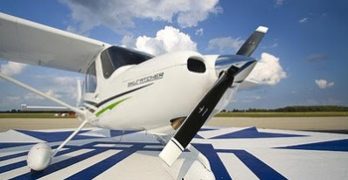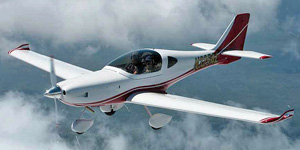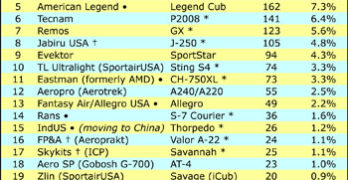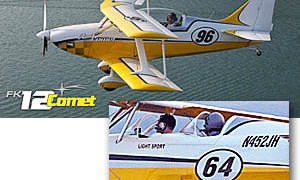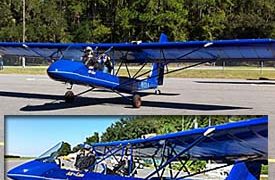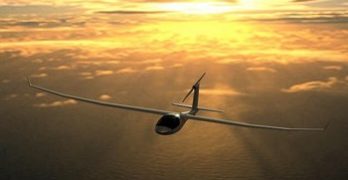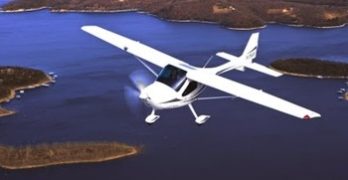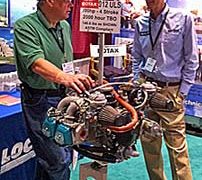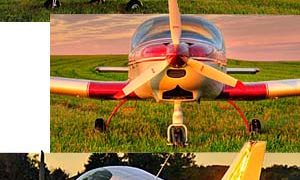In a recent piece on AvWeb, Paul Bertorelli takes a good look at Cessna’s decision to bump the price of the Skycatcher by a cool $35K — yes, that’s 35 thousand. Okay, it’s not every day we see a 31+% price hike in a retail price of anything, especially in this economy. *** Yet Cessna’s move should come as no surprise to anyone who knows, as Bertorelli points out, that the price of aircraft has grown faster than the rate of inflation for decades. Thirty years or so ago, a new Cessna Skyhawk could be had for around $30,000. Today it’s 10 times that number, or more than $300,000, whereas inflation applied to that original $30K number would put the figure just north of $100,000…about three times higher. *** Meanwhile, the aviation giant has up until now done its best to keep the price close to it’s original near-$100,000 level.
More and More, LSA Are Going Global
Since the beginning of LSA time, way back in 2005 (when the first LSA was approved), LSA have arrived on American shores from overseas factories. American producers also sold airplanes to Yankees, but none went overseas as governments of other nations had not yet accepted ASTM certification standards. In the last year, a lot has happened. *** At least four companies are selling LSA in other countries with aircraft defined by U.S.-originated parameters and meeting ASTM standards. LSA Global developments are reported by Arion Aircraft, U.S. Sport Aircraft (representing Czech Sport Aircraft), Remos Aircraft, and Flight Design. *** Yankee First? Arion Aircraft is one of the first all-American companies to go global with its production. The Marysville, Tennessee company — a related company to Jabiru U.S., which supplies the J230 and other high wing models to LSA buyers in the USA — has sent aircraft to Australia. The down-under country was one of the first to use ASTM certification after the new approval method was introduced by FAA in America.
Third Quarter 2011 LSA Market Report; Cessna Jumps
Sure enough, by several measures and based on multiple conversations, 2011 is shaping up to be a better year than 2010. Of course, that’s not saying much as all of aviation worldwide was slow last year and in 2009. When you’re near the bottom of the well, everything starts looking up. *** With those thoughts in mind, we present the newest market share report, this one through the third quarter of 2011. In recent years we’ve had folks tell us we ought to show charts of this year’s or this quarter’s performance. But most readers want to know the “installed base,” to borrow a phrase from the trend-setting tech industry. When people talk about Windows versus Apple market share or iOS versus Android, they generally mean how many of all buyers have those systems. *** Nonetheless, we recognize pilots are hungry for more recent info. So for several years, we have discussed near-term performance in the text of our articles even while we present a graphic showing FAA N-number registrations since the beginning.
FK Lightplanes Earns SLSA #123: FK12 Comet
As they’ve done numerous times, Hansen Air Group — a team of dedicated pilots, nearly all of whom fly or formerly flew airliners for their day job — has helped shepherd another Light-Sport Aircraft through the ASTM standards process to get a FAA airworthiness certificate. The Altanta area importer has done this with several aircraft including some Tecnam models, Sky Arrow, and Peregrine. In recent months, Hansen took over U.S. import duties for FK Lightplanes, which has facilities in Germany and Poland. *** Welcome to SLSA #123, the dashing FK12 Comet biplane. FK12 is the first-ever biplane to win SLSA approval, the second qualified LSA for FK Lightplanes, and the second LSA type to arrive in the USA for aerobatic flight (the first was the Snap from SportairUSA). FK12 made a first official U.S. appearance in the LSA Mall at AirVenture 2011 (as did Snap).
Is Flying for Fun Shrinking? Here’s Another View.
Our good friend, Mary Grady, posted an article on AVweb, one of our favorite aviation news sites; lots of good content available. Mary recently editorialized about electric aircraft and their potential appeal. Following the NASA Green Flight Challenge, her timing was as impeccable as her writing. I encourage you to go read the editorial, but what you’ll find at least as entertaining as Mary’s editorial are a great many reader comments; the topic clearly inspired aviators. *** That said, I had to write Mary* about one line and I want to share some of what I told her. *** Mary wrote, “For people who fly for fun — presuming there are many of those left, it seems to be one of the fastest-shrinking segments of GA — electric airplanes are sure to appeal.” *** In my communication to Mary, I asked about the source of the knowledge that flying for fun is shrinking.
Doing What You Cannot Do in Most Aircraft
My good friend and Air-Cam developer, Phil Lockwood, likes to hold fly-outs for his customers. More than 160 kits have been delivered and built; each fly-out has attracted several of these owners. Phil and his Lockwood Aircraft associate George Weber have invited me several times but I’ve had to miss earlier gatherings for owners of this iconic “twin engined ultralight” (it isn’t really an ultralight but has its roots in that category). For once I got to attend. The destination was the beautiful Jekyll Island resort area of Georgia; it’s near St. Simons Island, another popular vacation destination. *** On a stunningly beautiful day, I was privileged to take my wife and two friends aloft for 30-minute tours of the Island. This was great fun for all. But what made it especially interesting is that I did this in N912LA, one of three Air-Cams badly trashed by the tornado at Sun ‘n Fun 2011 (photo).
Green Flight Challenge Down to Final Three!
Updates 10/4/11 and 10/5/11 — Congratulations to Pipistrel for their unprecedented third win at a NASA Challenge. Picking up a cool $1.35 million, the company won with their unorthodox dual Taurus G2 fuselages joined by a larger, centrally-mounted electric engine. The custom-configured, four-seat aircraft achieved an amazing 403 passenger miles per gallon of fuel (or its equivalent). After this string of wins, Pipistrel has firmly placed itself in the lead position among highly efficient light aircraft and those powered with electric motors. *** NASA claims the prize purse was the biggest ever awarded for an aviation competition. In second-place a much smaller but still hefty check for $120,000 went to the German eGenius team, NASA announced. *** Read more from our friends at AvWeb and at Flying online. In addition, Aero-News offers a video with more on the potential of electric power (scroll to or search for “The Green Flight Challenge”).
REMOS GXeLite: Super Diet?
Sign of the times: cut costs wherever possible. And kudos to those LSA makers who can cut weight too! *** Remos Aircraft has a lower-priced, dramatically lighter version of its flagship GX that bears closer scrutiny. *** It’s called GXeLite, and lists at $133,924.The model is targeted at pilots, clubs and flights schools that don’t feel the need for all the latest high-tech glass and embellishments. Typically, “loaded” models like the GX and new GXNXT models price out at well over the wallet-flattening $150K mark. *** The eLite is dramatically lighter in empty weight too: just 638 lbs. (My recent flight report on the NXT listed that model’s empty weight at 718, or 90 lbs. heavier!). That would allow full tanks as well as some truly hefty passengers too, since the useful load is 682 lbs.! *** The main steps taken to lighten the load on the eLite include reinstating the composite landing gear, using carbon fiber instead of metal wing struts, new carbon fiber seats and a new instrument panel, which is lighter as well as lower.
Lockwood Rotax and Bristell at AOPA Summit 2011
At AOPA summit I spent time in the Lockwood Aviation booth giving me a chance to speak with a few RV-12 builders. *** Van’s has reportedly sold approximately 600 RV-12 Light-Sport Aircraft, of which 150 may be flying, making RV-12 by far the most successful Experimental LSA. RV-12 would among rank high among all Light-Sport Aircraft were we able to include ELSA in the SLSA List (…we cannot, for several reasons). In a sign that proprietor and industry leader Phil Lockwood sees good potential in RV-12 service work he displays the leading ELSA on his latest Lockwood Aircraft Supply catalog. Van’s did not exhibit at Summit 2011. *** I found it equally interesting to hear much improved reception to the Rotax line compared to earlier AOPA Expos or Summits. Perhaps it’s the 2,000-hour overhaul time. Maybe it’s the 40,000 9-series engines Rotax has installed on aircraft.
A Pair of New SLSA Arrive Before AOPA Summit 2011
Just in time for this year’s AOPA Summit, welcome to a pair of Special Light-Sport Aircraft, numbers 121 and 122: the first, the formerly named NG 5 LSA, rebadged as the Bristell Fastback by importer Liberty Sport Aviation of Pennsylvania; and the second being the fourth approval for Pipistrel, specifically for their Sinus motorglider (previous Pipistrel approvals included the Virus, Virus SW, and Taurus). *** NG 5 LSA was not previously offered in the U.S. though it was sold in Europe as the NG 4 from Roko Aero. When Roko closed its doors production stopped for the NG 4. It became NG 5 as the company reformed into BRM Aero. Changes occur in any industry but Bristell Fastback designer, Milan Bristela, is a steady hand on the joystick known for his foundational work on the SportCruiser (for a year known as the PiperSport) that is presently ranked #2 in U.S.
- « Previous Page
- 1
- …
- 26
- 27
- 28
- 29
- 30
- …
- 64
- Next Page »


